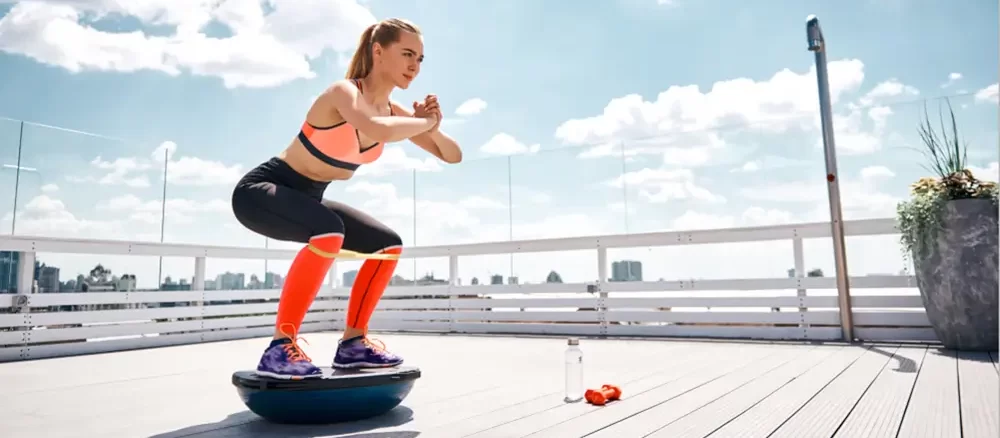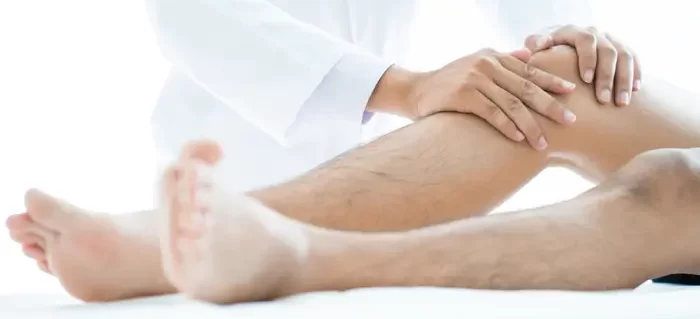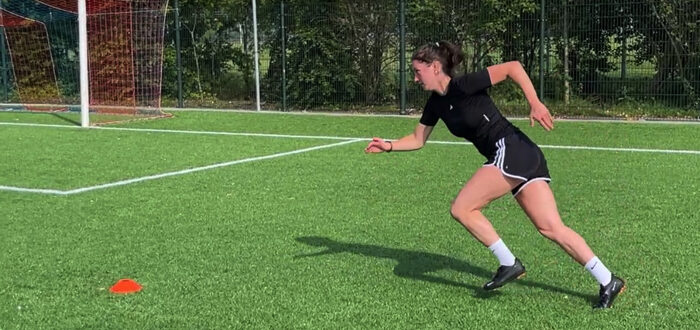
6 criteria for safe running after cruciate ligament surgery

Written by Michael de Levie
One of the main goals for a client after anterior cruciate ligament surgery is to be able to run again. A common question and what the physical therapist hears daily is " When can I start running". To safely run after anterior cruciate ligament surgery, you must meet a number of criteria. What criteria those are you will read in this blog.
When can I start running after anterior cruciate ligament surgery?
After anterior cruciate ligament surgery, a number of changes take place. The knee is stiff, swollen and muscle strength decreases at a rapid rate. The first few weeks you will walk on crutches where you will notice that the gait pattern is disturbed. It takes several weeks to months to regain a symmetrical gait pattern. The strength and walking technique must Be trained to run well.
What goes wrong when you start running too early?
Most rehabbers start running on a treadmill. A treadmill is predictable, you can set the speed and the tire is level. Running on the street will be more challenging with, among other things, crooked tiles. If you start running (a little) too early, rest assured not a whole lot can go wrong, but an irritated and/or irritated knee is possible. The result of an overused knee is more pain and sometimes a swollen knee. A disrupted running pattern can also lead to pain elsewhere in the chain of motion. Continuing to run and ignoring the pain is generally not helpful.
What goes wrong with running:
- The movement of the affected leg is small and stiff and the rhythm between the legs varies.
- Less extension and flexion of the knee relative to the other side.
- Passive heavy and/or sedentary walking pattern
- Landing with fully extended knee.
- Asymmetrical foot landing (forefoot and a heel landing other side)
In summary, there are several signs during running that may indicate an asymmetrical running pattern. It is important to listen to the rhythm and/or impact of the landing and observe the angle changes of the legs. A video analysis may be a consideration to map the running patternonn more accurately.
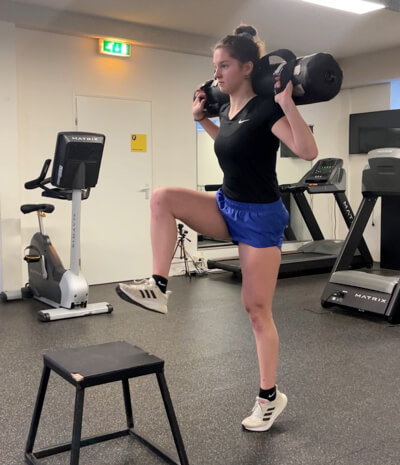
Criteria for starting running
The anterior cruciate ligament rehabilitation is going well. By now you have been training for a long period of time and strength is progressing well. The time has come when you ask your physical therapist: when can I start running? Previously, rehabilitation was time-based. From week 6 no more crutches, at week 14 start running and after 9 months you can play sports again. This method of rehabilitation proved unsustainable and often resulted in someone not being ready for a certain (sports) load. Cruciate ligament rehabilitation is an individual process and goes differently for everyone. This has led to criteria-based rehabilitation. An anterior cruciate ligament rehabilitation consists of phases, and each phase has criteria that must be met. Although research is still being done, (preliminary) criteria have also been established for running. If you meet these criteria, you may start running.
Clinical criteria:
- No to minimal swelling
- No to minimal pain (<2 NPRS)
- Knee flexion >120 degrees
- Full extension
If knee function has not fully recovered, running is not wise. The risk of strain, pain or irritation will increase.
Muscle strength criteria:
- Isokinetic (biodex) difference between legs should be less than 20%.
- Isometric strength test of the quadriceps should not exceed 30% difference.
Leg press en bepaalde kuit oefeningen can also be used. Here a guideline can be 1.25x body weight. Keep in mind that every leg press is different and so is the kilogram scale. So be cautious about drawing conclusions from this.
Functional criteria:
- One leg squat 10 reps.
- One-legged hops in a row.
- Hop testing.
Gemiddeld wordt gestart met hardlopen rond 12 weeks However, taking hop tests around that period is not wise and risky.
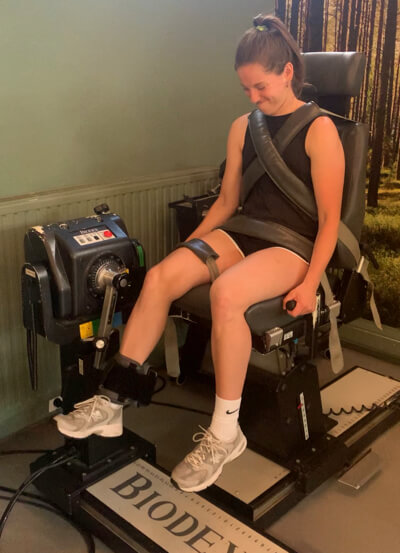
Starting running earlier or later
On average, around 12th week after surgery started running. Following the criteria, it is actually not possible to start running around 12 weeks for two reasons. Namely, one of the requirements for running is a force difference of less than 20 percent between both legs (isokinetic test biodex). The second reason is that we don't test until 4 months (week 16). If you start running before 4 months, you cannot objectively determine if the strength requirement has been met. It might well be a good development to start running later. This gives the knee more time for the healing process and strength development. How we should interpret and implement the criteria remains an interesting question and discussion. Below you can read how we deal with the criteria in our practice.
Here are the criteria we use in practice:
- No to minimal swelling
- Good extension
- Properly perform 4 series of 10 one-legged squats.
- Squat jumps 2 legged.
- One-legged dynamic well-executed hops 10 times in a row.
- Started tripping.
At our practice, we start running on average between weeks 12 and 18. For most rehabbers, starting running in week 12 is ambitious. My personal preference is to take a little more time and prepare the knee properly for running.
We're curious what week you started running and based on what your physical therapist decided. Leave a comment at the bottom of this blog.
Tips and building up running
If you want to start running again, it is important to realize that you often haven't run for months. So it is important to get your body used to the running load during anterior cruciate ligament rehabilitation. Here are four tips that can help with this.
Tip 1: Start with short intervals. An example is 3×30 seconds of running at a leisurely pace, interspersed with a one-minute active walking break.
Tip 2: Run at a relatively high stride rate (160-170 per minute).
Tip 3: Active running. An active knee commitment while running can help.
Tip 4: hardlopen zonder schoenen. Rennen zonder schoenen stimuleert het actieve looppatroon, doordat je automatisch een mid- of voorvoet landing krijgt. Let op: ben je niet gewend om te rennen zonder schoenen dan bestaat de kans op voet en kuitklachten. Mijn persoonlijke voorkeur is om revalidanten hard te laten lopen met schoenen. In uitzonderlijke gevallen kies ik ervoor om zonder schoenen te rennen om een actiever looppatroon te stimuleren.
As mentioned, let the body get used to running and build up the speed and duration slowly. Don't be alarmed if the knee is a little more sensitive after the first few runs that often goes away quickly. Increasing swelling and pain are indications to consult with your physical therapist. At several practices it is possible to do a running analysis. This may be a consideration if you continue to have symptoms with running.
Summary
Running is a complex form of exercise. Running requires investment in strength, stability and coordination. The running program should be built up gradually and take your time to do so. It is a shame that pain issues will arise from building up the program too progressively. I am curious to know what your experience was like starting running after anterior cruciate ligament surgery. Do you have any tips or ideas for fellow sufferers or are you a physical therapist and use different criteria. Leave a comment at the bottom of this blog.


